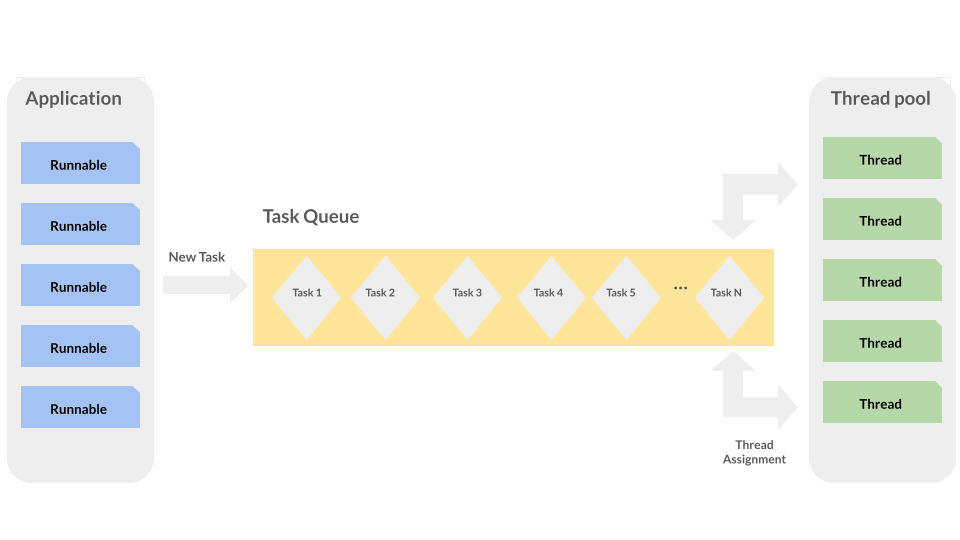Understanding Thread Pools, Worker Threads, and Types of Thread Pools
Concurrency and parallelism are essential for building efficient and responsive applications. In modern programming, thread pools are a powerful tool for managing and executing tasks concurrently. In this blog post, we’ll explore what thread pools are, the types of thread pools available, and how worker threads play a crucial role in their functionality.
What Is a Thread Pool?
A thread pool is a collection of pre-initialized worker threads that can execute tasks concurrently. Instead of creating a new thread for each task, tasks are submitted to the thread pool, which manages the execution of the tasks using the available threads. This approach offers several advantages:
- Efficiency: Reusing threads reduces the overhead of creating and destroying threads for each task.
- Resource Management: Limiting the number of threads controls the system resources being used.
- Concurrency Control: The pool can handle multiple tasks concurrently, providing better performance and responsiveness.
The diagram below briefly explains how a running application submits the tasks to a queue which takes up an available thread from the ‘thread pool’ to execute that task asynchronously.

Understanding Worker Threads
Worker threads are the threads within a thread pool that execute tasks. Here’s how they work:
- Task Assignment: Worker threads are assigned tasks from the thread pool’s queue and executed concurrently.
- Task Execution: Each worker thread runs its assigned task independently, enabling parallel processing of tasks.
- Reuse: Once a worker thread completes a task, it becomes available again to take on another task from the queue.
Types of Thread Pools
There are a few different types of thread pools that can be used depending on the use case.
1. Fixed-Size Thread Pool
A fixed-size thread pool initializes with a specific number of worker threads. This number remains constant throughout the pool’s lifecycle.
Example:
import java.util.concurrent.*;
public class FixedThreadPoolExample {
public static void main(String[] args) {
// Create a fixed-size thread pool with 4 threads
ExecutorService threadPool = Executors.newFixedThreadPool(4);
// Submit tasks to the thread pool
for (int i = 1; i <= 5; i++) {
final int taskNumber = i;
threadPool.execute(() -> {
System.out.println("Executing task " + taskNumber + " on thread: " + Thread.currentThread().getName());
});
}
// Shut down the thread pool once tasks are complete
threadPool.shutdown();
}
}
In this example, I create a fixed-size thread pool with 4 threads. I submit 5 tasks to the thread pool, which executes them concurrently using the available worker threads.
2. Cached Thread Pool
A cached thread pool can create new threads as needed to handle incoming tasks but will shut down idle threads after a certain period of inactivity. This type of pool adjusts its size based on the workload.
Example:
import java.util.concurrent.*;
public class CachedThreadPoolExample {
public static void main(String[] args) {
// Create a cached thread pool
ExecutorService threadPool = Executors.newCachedThreadPool();
// Submit tasks to the thread pool
for (int i = 1; i <= 5; i++) {
final int taskNumber = i;
threadPool.execute(() -> {
System.out.println("Executing task " + taskNumber + " on thread: " + Thread.currentThread().getName());
});
}
// Shut down the thread pool once tasks are complete
threadPool.shutdown();
}
}
In this example, I create a cached thread pool and submit 5 tasks to it. The thread pool dynamically adjusts the number of worker threads based on the workload.
3. Scheduled Thread Pool
A scheduled thread pool is designed for scheduling tasks at fixed-rate intervals or with delays. This type of pool is useful for running tasks periodically or at specific times.
Example:
import java.util.concurrent.*;
public class ScheduledThreadPoolExample {
public static void main(String[] args) {
// Create a scheduled thread pool with 2 threads
ScheduledExecutorService threadPool = Executors.newScheduledThreadPool(2);
// Schedule tasks to run at fixed-rate intervals
Runnable task = () -> {
System.out.println("Running task on thread: " + Thread.currentThread().getName());
};
threadPool.scheduleAtFixedRate(task, 1, 2, TimeUnit.SECONDS);
// The thread pool continues to run the task at fixed intervals
// It can be shut down after a certain period, depending on your use case
}
}
In this example, we create a scheduled thread pool with 2 threads and schedule a task to run at fixed-rate intervals (every 2 seconds, starting 1 second after initialization).
Conclusion
Thread pools, worker threads, and the different types of thread pools provide a robust and efficient way to manage concurrency in your applications. By choosing the right type of thread pool for your tasks and understanding how they work, you can optimize the performance and responsiveness of your code.
I hope this blog post has helped you understand the basics of thread pools and how they interact with worker threads. Let us know in the comments if you have any questions or suggestions for future posts!
Happy coding!



